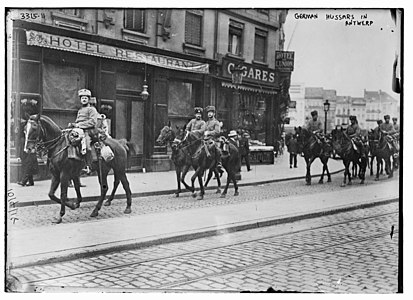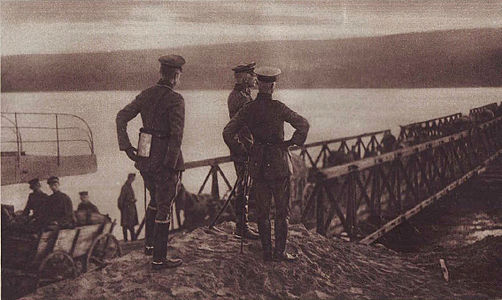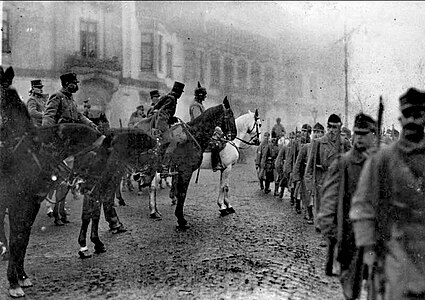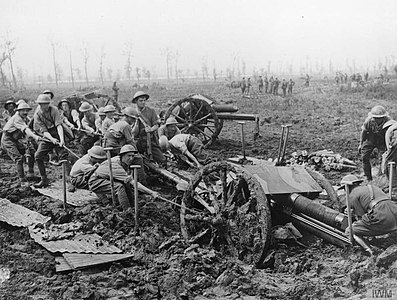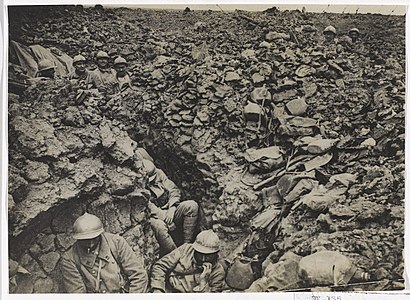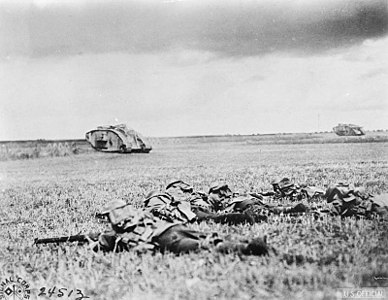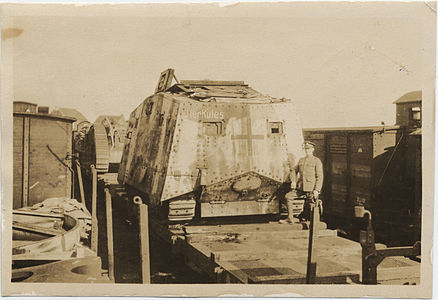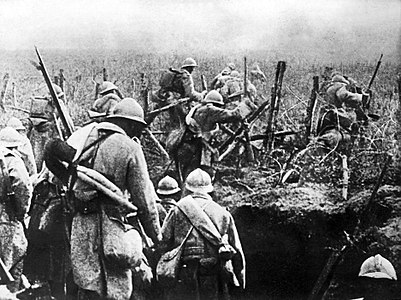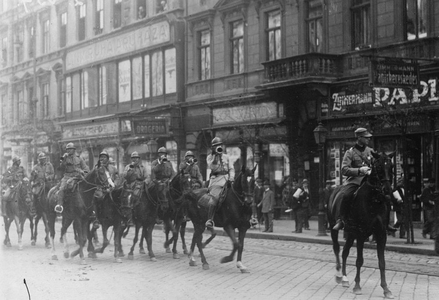Marsh Wars (Pacifica): Difference between revisions
No edit summary Tag: 2017 source edit |
LordGianni (talk | contribs) m (Added categories) Tag: 2017 source edit |
||
| (17 intermediate revisions by one other user not shown) | |||
| Line 15: | Line 15: | ||
}} | }} | ||
| date = 5 September 1914 - 13 November 1918 | | date = 5 September 1914 - 13 November 1918 | ||
| place = {{Pacifica|Stoinia}} & {{Pacifica|Ezervulge}} | | place = {{Pacifica|Stoinia}} & {{Pacifica|Ezervulge}},<br>{{Pacifica|Bailtem}} | ||
| coordinates = <!--Use the {{coord}} template --> | | coordinates = <!--Use the {{coord}} template --> | ||
| map_type = | | map_type = | ||
| Line 36: | Line 36: | ||
| combatant2 = {{flag|Ezervulge}} | | combatant2 = {{flag|Ezervulge}} | ||
| combatant3 = | | combatant3 = | ||
| commander1 = {{flagicon|Stoinia}} '''Alexandru VIII'''<br/>{{flagicon|Stoinia}} Field Marshal {{Pacifica|Sergiu Vernescu}}<br/>{{flagicon|Stoinia}} General {{Pacifica|Jorge Aranda}}<br/>{{flagicon|Stoinia}} General {{Pacifica|Ramiro De Sarro}} | | commander1 = {{flagicon|Stoinia}} '''Alexandru VIII'''<br/>{{flagicon|Stoinia}} Field Marshal {{Pacifica|Sergiu Vernescu}}<br/>{{flagicon|Stoinia}} General {{Pacifica|Jorge Aranda}}<br/>{{flagicon|Stoinia}} General {{Pacifica|Ramiro De Sarro}}<br/>{{flagicon|Stoinia}} General {{Pacifica|Constantin Preda}} | ||
| commander2 = {{flagicon|Ezervulge}} '''George II'''<br>{{flagicon|}}<small>''Gyorgy II''</small><br/>{{flagicon|Ezervulge}} Field Marshal {{Pacifica|Mákkeszőr Ámbrus}}<br/>{{flagicon|Ezervulge}} General {{Pacifica|Horváth László}}<br/>{{flagicon|Ezervulge}} General {{Pacifica|Szilágyi Dénes}} | <!--{{flagicon|Stoinia}} General {{Pacifica|Gheorghe Butoiu}}<br/>{{flagicon|Stoinia}} General {{Pacifica|Piero Casardi}}<br/>{{flagicon|Stoinia}} General {{Pacifica|Gheorghe Măcărescu}}<br/>{{flagicon|Stoinia}} General {{Pacifica|Egídio Varejão}}<br/>{{flagicon|Stoinia}} General {{Pacifica|Staur Fălcoianu}}--> | ||
| commander2 = {{flagicon|Ezervulge}} '''George II'''<br>{{flagicon|}}<small> ''Gyorgy II''</small><br/>{{flagicon|Ezervulge}} Field Marshal {{Pacifica|Mákkeszőr Ámbrus}}<br/>{{flagicon|Ezervulge}} General {{Pacifica|Horváth László}}<br/>{{flagicon|Ezervulge}} General {{Pacifica|Szilágyi Dénes}} | |||
| commander3 = | | commander3 = | ||
| units1 = | | units1 = | ||
| Line 45: | Line 46: | ||
| strength2 = {{flagicon|Ezervulge}} 1,260,000 | | strength2 = {{flagicon|Ezervulge}} 1,260,000 | ||
| strength3 = | | strength3 = | ||
| casualties1 = | | casualties1 = 387,000 killed<br/>480,000 wounded | ||
| casualties2 = | | casualties2 = 396,000 killed<br/>420,000 wounded | ||
| casualties3 = | | casualties3 = | ||
| notes = | | notes = | ||
| campaignbox = | | campaignbox = | ||
}} | }} | ||
The '''Marsh Wars''' ({{Pacifica|Castonish}}: ''Guerras de las Marismas''; Ezervulgish: ''Mocsarak háborúi'') were a series of conflicts in the early 20th century as a result of a decade of crumbling {{Pacifica|Stoinia-Ezervulge relations|Stoino-Ezervulgish relations}}. Open hostilities began on 5 September 1914 and would be marked by both swithering and static frontlines until 13 November 1918. The war would be named after the formation of marshes due to extreme weather conditions elevated through trench warfare. The conflict was one of {{Pacifica|Pacifica}}'s first wars with the widespread use of trenches, chemical weapons, tank warfare and modern infantry tactics. | The '''Marsh Wars''' ({{Pacifica|Castonish}}: ''Guerras de las Marismas''; Ezervulgish: ''Mocsarak háborúi'') were a series of conflicts in the early 20th century as a result of a decade of crumbling {{Pacifica|Stoinia-Ezervulge relations|Stoino-Ezervulgish relations}}. Open hostilities began on 5 September 1914 and would be marked by both swithering and static frontlines until 13 November 1918. The war would be named after the formation of marshes due to extreme weather conditions elevated through trench warfare. The conflict was one of {{Pacifica|Pacifica}}'s first wars with the widespread use of trenches, chemical weapons, tank warfare and modern infantry tactics. The Marsh Wars would go down in history as one of the most innovative wars as well as one with the highest casualties due to disease. Ultimately, {{Pacifica|Stoinia}} would come out on top with the capture of Sárkanyvölgy and sue for peace in the controversial {{Pacifica|Treaty of Kétvár}} which saw the displacement of 180,000 of the Ezervulgish minority in {{Pacifica|Stoinia}}, war reparations and eventual social issues within {{Pacifica|Ezervulge}}. | ||
==Background== | ==Background== | ||
Both {{Pacifica|Stoinia}} and {{Pacifica|Ezervulge}} had become industrialised societies following the industrial revolution. | Both {{Pacifica|Stoinia}} and {{Pacifica|Ezervulge}} had become industrialised societies following the industrial revolution. Although a significant discrepancy was present due to {{Pacifica|Ezervulge}} losing a large portion of its industrial power after {{Pacifica|Peter I's War}}, the nation was slowly catching up again to western maritime powers such as {{Pacifica|Stoinia}} and {{Pacifica|Sedunn}} with the support of the {{Pacifica|Austral Empire}}. It was in this spirit of catching up that the Ezervulgish King {{Pacifica|Gyorgy II|George II}}, upon his ascension in 1906, sought a policy of pan-Ezervulgism which brought it head-to-head with {{Pacifica|Stoinia}} which housed some 300,000 Ezervulgish in the {{Pacifica|Loreto}}, {{Pacifica|Corrientes}} and {{Pacifica|Váceres}} provinces since the {{Pacifica|Hunyars}}' {{Pacifica|Sacking of Tolosa}}. King {{Pacifica|Gyorgy II|George II}} wished to establish a dominant Bailtemmic nation with all Ezervulgish people under one rule. These border provinces, in addition to hosting Ezervulgish minorities, were rich in coal and steel mines which would help fuel the further industrialisation of {{Pacifica|Ezervulge}}. Furthermore, in 1911 large deposits of gold were found in the Stoinian {{Pacifica|Corrientes}} province which could spearhead Ezervulge's global economic trade power. It was hoped that their incorporation would resurge {{Pacifica|Ezervulge}} as a Bailtemmic power since the defeat in {{Pacifica|Peter I's War}} as well as serve as a long-term economic investment to consolidate Ezervulgish prosperity, which in turn would again strengthen the position of the Ezervulgish King. | ||
{{Pacifica|Stoinia}} was focusing on its overseas territories through industrial development programs. Especially {{Pacifica|Shai Kong}}'s harbour expansion had become a priority against {{Pacifica|Huawan|Paeonisian}} and {{Pacifica|Izaakian}} competition as {{Pacifica|Stoinia}} wished to maintain its role in global trade. Recently, {{Pacifica|Shai Kong}} had become overcrowded and the | {{Pacifica|Stoinia}} was focusing on its overseas territories through industrial development programs. Especially {{Pacifica|Shai Kong}}'s harbour expansion had become a priority against {{Pacifica|Huawan|Paeonisian}} and {{Pacifica|Izaakian}} competition as {{Pacifica|Stoinia}} wished to maintain its role in global trade. Recently, {{Pacifica|Shai Kong}} had become overcrowded and the lack of infrastructure had made {{Pacifica|Hai Men Island}} a preferable choice over {{Pacifica|Shai Kong}}. This required government intervention overseas to fully develop {{Pacifica|Corinia|Corinian}} industries so that they may operate autonomously. In addition, citizens overseas had grown their own identities which had caused incidents of rebellion. As such, {{Pacifica|Prime Minister of Stoinia|Prime Minister}} {{Pacifica|Tiberiu Stolojan}} frequently voyaged to {{Pacifica|Corinia}} and {{Pacifica|Carraca}} to oversee the industrialisation of the overseas territories. This would however invite Ezervulgish opportunism. | ||
{{Pacifica|Stoinia-Ezervulge relations|Stoino-Ezervulgish relations}} would start to deteriorate from | {{Pacifica|Stoinia-Ezervulge relations|Stoino-Ezervulgish relations}} would start to deteriorate from late 1906 as Ezervulgish Ambassadors would become increasingly volatile and propagate stories of how Ezervulgish in Stoinia are abused by Stoinian governance. Later studies would show that Ezervulgish marginalisation happened due to significant language barriers in local administrations. Nonetheless, the Ezervulgish rhetoric only grew more zealous over the years until it reached a breaking point on 5 September 1914 when {{Pacifica|Ezervulge}} formally declared war with the intent to liberate the Ezervulgish minority in {{Pacifica|Stoinia}}. | ||
==Strategy== | ==Strategy== | ||
===Stoinia=== | ===Stoinia=== | ||
[[File:Romanian Officers WWI.jpg|left|thumb|250x250px|Generals {{Pacifica|Constantin Preda}}, {{Pacifica|Gheorghe Butoiu}}, {{Pacifica|Piero Casardi}}, {{Pacifica|Egídio Varejão}} & {{Pacifica|Gheorghe Măcărescu}} during a military parade in 1909.]]Line infantry had largely remained the main doctrine of the {{Pacifica|Stoinian Royal Army}}, which had been cemented by the {{Pacifica|Elbonian Wars}}. However, the military staff was in an era of rejuvenation in the latter half of the 19th century. Under the New College ({{Pacifica|Castonish}}: ''Nuevo Colegio''), young officers brought a wind of change through pressure to modernise infantry tactics under the guidance of the rising General {{Pacifica|Jorge Aranda}}. Nonetheless, the Stoinian government from 1880 to 1910 had primarily focused on modernising the {{Pacifica|Stoinian Royal Navy}} which consequently brought forms of stagnation to the {{Pacifica|Stoinian Royal Army|Royal Army}}. Stoinian military staff was known for tense relations between the naval & army branches as well as for internal tension within the Royal Army staff. | |||
The Stoinian military-industrial complex would however continue to revolutionise military equipment such as machine guns, helmets and artillery cannons. The New College would be spread over the issues where to focus new Stoinian Royal Army doctrine by the means of new equipment. Military theorists formulated strategies utilising prototype aircraft as well as train-mounted artillery. During this period, not one doctrine was dominant as the military leadership was spread on the various strategies. Instead, the military staff encouraged officers to take the initiative and experiment in military exercises.<br> | |||
This was only strengthened through Stoinian officers partaking in joint military exercises with other nations such as {{Pacifica|Sedunn}} and rising naval powers like {{Pacifica|Karnetvor}} and {{Pacifica|Techganet}}. At the start of the 20th century, {{Pacifica|Stoinia-Ezervulge relations|Stoino-Ezervulgish relations}} were still amicable and officers such as Major-General {{Pacifica|Ramiro De Sarro}} and General {{Pacifica|Mákkeszőr Ámbrus}} engaged in bilateral training exercises incorporating tactics to test out new military equipment. Ezervulgish prototypes had gained the interest of Stoinian military staff and Major-General {{Pacifica|Ramiro De Sarro}} was sent to evaluate the merits. However, political forces had pressured to prioritise naval investments over equipment modernisation. | |||
The Stoinian military at the time largely comprised volunteers and was slowly becoming more and more professionalised. It primarily served as a way for aristocratic families to serve the Kingdom, but recent liberalisation policies opened up leadership positions to soldiers from the ranks. This brought a new wave in the military leadership who largely joined the New College's beliefs to modernise the institution. Even though social stigmas were present, the {{Pacifica|Stoinian Royal Army}} would continue to pursue a course towards liberalisation and innovation.<br> | |||
[[File:August von Mackensen in Sofia 1916.jpg| | ===Ezervulge — ''Szilágyi''-plan=== | ||
[[File:Marsh Wars - Szilagyi.png|left|thumb|The Szilágyi-plan stipulated by General {{Pacifica|Szilágyi Dénes}}]]Ezervulgish military staff had focused on modernising its equipment and subsequently its tactics. Various prototypes of planes, tanks, guns and logistical equipment had been fueled by the scarcity of resources in {{Pacifica|Ezervulge}}. Having received some industrial support from {{Pacifica|Austra}}, the Ezervulgish continued to develop new weapons despite the technological discrepancy when compared to {{Pacifica|Sedunn}} and {{Pacifica|Stoinia}}. The technological innovation made by the Ezervulgish military-industrial complex from 1901 to 1905 had garnered the attention of Stoinian prospects under the mission of Major-General {{Pacifica|Ramiro De Sarro}} in the 1904 Stoino-Ezervulgish military conference. General {{Pacifica|Mákkeszőr Ámbrus}} especially had become a rising military strategist and theorist by modernising Ezervulgish war doctrines. Despite the amicable {{Pacifica|Stoinia-Ezervulge relations|Stoino-Ezervulgish relations}} and the friendship between General {{Pacifica|Mákkeszőr Ámbrus|Mákkeszőr}} and Major-General {{Pacifica|Ramiro De Sarro|De Sarro}}, {{Pacifica|Stoinia-Ezervulge relations|Stoino-Ezervulgish relations}} would crumble following the new policies since King {{Pacifica|Gyorgy II|George II}}'s ascension. | |||
Ezervulgish doctrine heavily emphasised the use of cavalry with the {{Pacifica|Hunyászok}} establishing themselves as elite cavalrymen in prior conflicts with {{Pacifica|Myria}}. Ezervulgish horses remained among the most prized in {{Pacifica|Bailtem}} and their genetic predisposition to fast acceleration and agility meant they had a natural advantage over other cavalries. General {{Pacifica|Mákkeszőr Ámbrus|Mákkeszőr}} would also spearhead the use of semi-automatic pistols within the {{Pacifica|Hunyászok}} to maximise their effectiveness in cutting through dispersed enemy troops. Typically, the Ezervulgish commanders would barrage the enemy with mobile artillery and shortly after send in the cavalry to finish the job as their form of [[:en:Shock_and_awe|shock and awe strategy]]. It was said that the {{Pacifica|Hunyászok}}'s wore iron braids to signal their arrival over their galloping horses and serve as psychological warfare alongside the skulls on their [[:en:Busby_(military_headdress)|''kucsma'' headdresses]]. | |||
[[File:August von Mackensen in Sofia 1916.jpg|right|thumb|350px|Ezervulgish military staff lead by Field Marshal {{Pacifica|Mákkeszőr Ámbrus|Mákkeszőr}} (centre-left) with King {{Pacifica|Gyorgy II|George II}} (centre-right) formulating the Szilágyi-plan at a military conference in Sárkanyvölgy, September 1913.]]The Ezervulgish military-industrial complex would also come up with new ways to modernise warfare through primitive tanks (Ezervulgish: ''viharszekér'') and chemical warfare through the weaponization of mustard and chlorine gas. These new tools of war would come to their full fruition during the Marsh Wars in an attempt to break the trench formations. In spite of weaker Ezervulgish industrial capabilities, they continued to innovate weapons to level out the playing field. | |||
In 1913, King {{Pacifica|Gyorgy II|George II}} would hold a military conference to stipulate a working strategy to conquer the Stoinian provinces which housed Ezervulgish minorities in {{Pacifica|Loreto}}, {{Pacifica|Corrientes}} and {{Pacifica|Váceres}} as well as the industrial infrastructure in {{Pacifica|Mérida}} and {{Pacifica|Castellón}}. Certain plans stipulate the complete annexation of {{Pacifica|Castonia}} and gain access to the {{Pacifica|South Pacific Ocean}} bypassing {{Pacifica|Sedunn}}'s control of the {{Pacifica|Strait of Saint Michael}}, but it became clear that such an extensive military operation would provoke future revanchism which {{Pacifica|Ezervulge}} likely couldn't hold back. As such a compromise was struck by General {{Pacifica|Szilágyi Dénes}} to capture Stoinian territory with Ezervulgish minorities up to the {{Pacifica|Narcea}} river at the industrial centre of {{Pacifica|Carreño}}. The main strategy to accomplish such a task would be the usage of train-mounted artillery which would systematically be captured by superior Ezervulgish cavalry. A strategy of alternating bombardment and precise slashing was believed to bring a swift Ezervulgish victory as no passages in the {{Pacifica|Varcathian mountains}} large enough to host armies were known to Ezervulgish military command. | |||
==Events== | ==Events== | ||
| Line 81: | Line 91: | ||
</gallery> | </gallery> | ||
====Stoinian counter-offensive & | ====Stoinian counter-offensive & Flooding of the Ebro==== | ||
<!-- Mákkeszor subordinents not as ligistically inclide, guerilla resistance, cut off from supplies--> | |||
<gallery mode="packed" gallery widths="200" heights="200" caption="Flooding of the Ebro"> | |||
Inondation Ramskapelle.jpg|Flooding in Loreto following the building of the dyke in {{Pacifica|Sariego}}. | |||
Wet and muddy trench (4687876853).jpg|Mudded Ezervulgish trench following the flooding of the {{Pacifica|Ebro}}. | |||
Chateau Wood Ypres 1917.jpg|Ezervulgish lines east of Noreña in 1915. | |||
The Battle of Passchendaele, July-november 1917 Q6236.jpg|14th Ezervulgish Artillery Battalion stuck near the Cudillero front in 1915. | |||
</gallery> | |||
===Second Marsh War=== | ===Second Marsh War=== | ||
| Line 88: | Line 106: | ||
<gallery mode="packed" gallery widths="200" heights="200" caption="Summer War"> | <gallery mode="packed" gallery widths="200" heights="200" caption="Summer War"> | ||
French soldiers of the 87th Regiment shelter in their trenches at Hill 304 at Verdun.jpg| | French soldiers of the 87th Regiment shelter in their trenches at Hill 304 at Verdun.jpg|The 87th Regiment in watered-down trenches during the Second Battle of Nagena. | ||
Infantry Behind Tanks. One Platoon of Infantry Follows Up Each Tank. Q57694.jpg|Stoinian tank escorted by a platoon at the Battle of X. | Infantry Behind Tanks. One Platoon of Infantry Follows Up Each Tank. Q57694.jpg|Stoinian {{Pacifica|Toro II}} tank escorted by a platoon at the Battle of X. | ||
German tank, Ramillies (sic) (19704944030).jpg|Ezervulgish | Stoinian Gas Masks.webp|Stoinian soldiers of the 56th Regiment wearing newly issued gas masks for protection against gas attacks. | ||
1916- august - Trupe române trecând Carpaţii.PNG|Stoinian | German tank, Ramillies (sic) (19704944030).jpg|Ezervulgish {{Pacifica|Viharszekér II}} tank unloaded for the Second Battle of Nagena. | ||
1916- august - Trupe române trecând Carpaţii.PNG|Stoinian Royal 3rd Army marching through Varcathian mountain passes to flank Ezervulgish lines. | |||
</gallery> | </gallery> | ||
| Line 98: | Line 117: | ||
<gallery mode="packed" gallery widths="200" heights="200" caption="''Caballo Salvaje'' offensive"> | <gallery mode="packed" gallery widths="200" heights="200" caption="''Caballo Salvaje'' offensive"> | ||
Bataille de Verdun 1916.jpg|Stoinian | Bataille de Verdun 1916.jpg|Stoinian 4th Army during the initial phase of the ''Caballo Salvaje'' offensive. | ||
Tanks passing dead Germans who were alive before the cavalry advanced a few minutes before the picture was taken (4688619576).jpg|Stoinian tanks advancing Ezervulgish fields. | Tanks passing dead Germans who were alive before the cavalry advanced a few minutes before the picture was taken (4688619576).jpg|Stoinian {{Pacifica|Toro II}} tanks advancing into Ezervulgish fields. | ||
RomanianCavalryBudapest.png|Stoinian | RomanianCavalryBudapest.png|Stoinian 7th Cavalry Regiment in Sárkanyvölgy. | ||
Hungarian-Romanian War of 1919 (National Military Museum Collection) 21.jpg|King Alexandru VIII inspecting troops in Sárkanyvölgy. | Hungarian-Romanian War of 1919 (National Military Museum Collection) 21.jpg|King Alexandru VIII inspecting troops in Sárkanyvölgy. | ||
RomanianSoldiersFeedingCiviliansInBudapest.jpg|Stoinian troops feeding Ezervulgish citizens. | RomanianSoldiersFeedingCiviliansInBudapest.jpg|Stoinian troops of the Royal 3rd Army feeding Ezervulgish citizens. | ||
</gallery> | </gallery> | ||
| Line 113: | Line 132: | ||
===Controversy=== | ===Controversy=== | ||
<!-- Tribunates not granted when created as too few Ezervulgish in spread out communities, left the Ezervulgish disgruntled for their own Tribunate--> | <!-- Tribunates not granted when created as too few Ezervulgish in spread out communities, left the Ezervulgish disgruntled for their own Tribunate--> | ||
[[Category:Stoinia (Pacifica)]] | |||
[[Category:Ezervulge (Pacifica)]] | |||
Latest revision as of 16:00, 1 May 2024
| Marsh Wars | |||||||
|---|---|---|---|---|---|---|---|
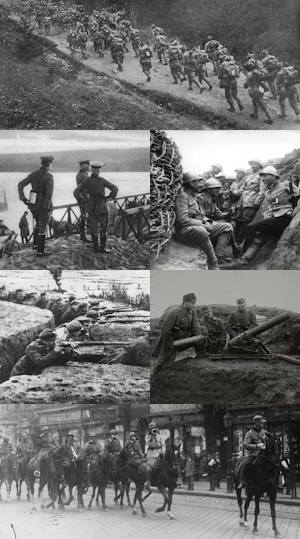 (clockwise)
| |||||||
| |||||||
| Main belligerents | |||||||
|
|
| ||||||
| Commanders and leaders | |||||||
|
|
| ||||||
| Strength | |||||||
|
|
| ||||||
| Casualties and losses | |||||||
|
387,000 killed 480,000 wounded |
396,000 killed 420,000 wounded | ||||||
The Marsh Wars (Castonish: Guerras de las Marismas; Ezervulgish: Mocsarak háborúi) were a series of conflicts in the early 20th century as a result of a decade of crumbling Stoino-Ezervulgish relations. Open hostilities began on 5 September 1914 and would be marked by both swithering and static frontlines until 13 November 1918. The war would be named after the formation of marshes due to extreme weather conditions elevated through trench warfare. The conflict was one of Pacifica's first wars with the widespread use of trenches, chemical weapons, tank warfare and modern infantry tactics. The Marsh Wars would go down in history as one of the most innovative wars as well as one with the highest casualties due to disease. Ultimately, Stoinia would come out on top with the capture of Sárkanyvölgy and sue for peace in the controversial Treaty of Kétvár which saw the displacement of 180,000 of the Ezervulgish minority in Stoinia, war reparations and eventual social issues within Ezervulge.
Background
Both Stoinia and Ezervulge had become industrialised societies following the industrial revolution. Although a significant discrepancy was present due to Ezervulge losing a large portion of its industrial power after Peter I's War, the nation was slowly catching up again to western maritime powers such as Stoinia and Sedunn with the support of the Austral Empire. It was in this spirit of catching up that the Ezervulgish King George II, upon his ascension in 1906, sought a policy of pan-Ezervulgism which brought it head-to-head with Stoinia which housed some 300,000 Ezervulgish in the Loreto, Corrientes and Váceres provinces since the Hunyars' Sacking of Tolosa. King George II wished to establish a dominant Bailtemmic nation with all Ezervulgish people under one rule. These border provinces, in addition to hosting Ezervulgish minorities, were rich in coal and steel mines which would help fuel the further industrialisation of Ezervulge. Furthermore, in 1911 large deposits of gold were found in the Stoinian Corrientes province which could spearhead Ezervulge's global economic trade power. It was hoped that their incorporation would resurge Ezervulge as a Bailtemmic power since the defeat in Peter I's War as well as serve as a long-term economic investment to consolidate Ezervulgish prosperity, which in turn would again strengthen the position of the Ezervulgish King.
Stoinia was focusing on its overseas territories through industrial development programs. Especially Shai Kong's harbour expansion had become a priority against Paeonisian and Izaakian competition as Stoinia wished to maintain its role in global trade. Recently, Shai Kong had become overcrowded and the lack of infrastructure had made Hai Men Island a preferable choice over Shai Kong. This required government intervention overseas to fully develop Corinian industries so that they may operate autonomously. In addition, citizens overseas had grown their own identities which had caused incidents of rebellion. As such, Prime Minister Tiberiu Stolojan frequently voyaged to Corinia and Carraca to oversee the industrialisation of the overseas territories. This would however invite Ezervulgish opportunism.
Stoino-Ezervulgish relations would start to deteriorate from late 1906 as Ezervulgish Ambassadors would become increasingly volatile and propagate stories of how Ezervulgish in Stoinia are abused by Stoinian governance. Later studies would show that Ezervulgish marginalisation happened due to significant language barriers in local administrations. Nonetheless, the Ezervulgish rhetoric only grew more zealous over the years until it reached a breaking point on 5 September 1914 when Ezervulge formally declared war with the intent to liberate the Ezervulgish minority in Stoinia.
Strategy
Stoinia

Line infantry had largely remained the main doctrine of the Stoinian Royal Army, which had been cemented by the Elbonian Wars. However, the military staff was in an era of rejuvenation in the latter half of the 19th century. Under the New College (Castonish: Nuevo Colegio), young officers brought a wind of change through pressure to modernise infantry tactics under the guidance of the rising General Jorge Aranda. Nonetheless, the Stoinian government from 1880 to 1910 had primarily focused on modernising the Stoinian Royal Navy which consequently brought forms of stagnation to the Royal Army. Stoinian military staff was known for tense relations between the naval & army branches as well as for internal tension within the Royal Army staff.
The Stoinian military-industrial complex would however continue to revolutionise military equipment such as machine guns, helmets and artillery cannons. The New College would be spread over the issues where to focus new Stoinian Royal Army doctrine by the means of new equipment. Military theorists formulated strategies utilising prototype aircraft as well as train-mounted artillery. During this period, not one doctrine was dominant as the military leadership was spread on the various strategies. Instead, the military staff encouraged officers to take the initiative and experiment in military exercises.
This was only strengthened through Stoinian officers partaking in joint military exercises with other nations such as Sedunn and rising naval powers like Karnetvor and Techganet. At the start of the 20th century, Stoino-Ezervulgish relations were still amicable and officers such as Major-General Ramiro De Sarro and General Mákkeszőr Ámbrus engaged in bilateral training exercises incorporating tactics to test out new military equipment. Ezervulgish prototypes had gained the interest of Stoinian military staff and Major-General Ramiro De Sarro was sent to evaluate the merits. However, political forces had pressured to prioritise naval investments over equipment modernisation.
The Stoinian military at the time largely comprised volunteers and was slowly becoming more and more professionalised. It primarily served as a way for aristocratic families to serve the Kingdom, but recent liberalisation policies opened up leadership positions to soldiers from the ranks. This brought a new wave in the military leadership who largely joined the New College's beliefs to modernise the institution. Even though social stigmas were present, the Stoinian Royal Army would continue to pursue a course towards liberalisation and innovation.
Ezervulge — Szilágyi-plan
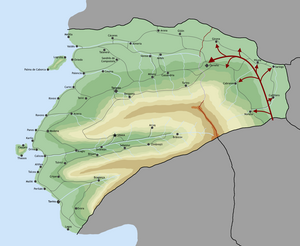
Ezervulgish military staff had focused on modernising its equipment and subsequently its tactics. Various prototypes of planes, tanks, guns and logistical equipment had been fueled by the scarcity of resources in Ezervulge. Having received some industrial support from Austra, the Ezervulgish continued to develop new weapons despite the technological discrepancy when compared to Sedunn and Stoinia. The technological innovation made by the Ezervulgish military-industrial complex from 1901 to 1905 had garnered the attention of Stoinian prospects under the mission of Major-General Ramiro De Sarro in the 1904 Stoino-Ezervulgish military conference. General Mákkeszőr Ámbrus especially had become a rising military strategist and theorist by modernising Ezervulgish war doctrines. Despite the amicable Stoino-Ezervulgish relations and the friendship between General Mákkeszőr and Major-General De Sarro, Stoino-Ezervulgish relations would crumble following the new policies since King George II's ascension.
Ezervulgish doctrine heavily emphasised the use of cavalry with the Hunyászok establishing themselves as elite cavalrymen in prior conflicts with Myria. Ezervulgish horses remained among the most prized in Bailtem and their genetic predisposition to fast acceleration and agility meant they had a natural advantage over other cavalries. General Mákkeszőr would also spearhead the use of semi-automatic pistols within the Hunyászok to maximise their effectiveness in cutting through dispersed enemy troops. Typically, the Ezervulgish commanders would barrage the enemy with mobile artillery and shortly after send in the cavalry to finish the job as their form of shock and awe strategy. It was said that the Hunyászok's wore iron braids to signal their arrival over their galloping horses and serve as psychological warfare alongside the skulls on their kucsma headdresses.

The Ezervulgish military-industrial complex would also come up with new ways to modernise warfare through primitive tanks (Ezervulgish: viharszekér) and chemical warfare through the weaponization of mustard and chlorine gas. These new tools of war would come to their full fruition during the Marsh Wars in an attempt to break the trench formations. In spite of weaker Ezervulgish industrial capabilities, they continued to innovate weapons to level out the playing field.
In 1913, King George II would hold a military conference to stipulate a working strategy to conquer the Stoinian provinces which housed Ezervulgish minorities in Loreto, Corrientes and Váceres as well as the industrial infrastructure in Mérida and Castellón. Certain plans stipulate the complete annexation of Castonia and gain access to the South Pacific Ocean bypassing Sedunn's control of the Strait of Saint Michael, but it became clear that such an extensive military operation would provoke future revanchism which Ezervulge likely couldn't hold back. As such a compromise was struck by General Szilágyi Dénes to capture Stoinian territory with Ezervulgish minorities up to the Narcea river at the industrial centre of Carreño. The main strategy to accomplish such a task would be the usage of train-mounted artillery which would systematically be captured by superior Ezervulgish cavalry. A strategy of alternating bombardment and precise slashing was believed to bring a swift Ezervulgish victory as no passages in the Varcathian mountains large enough to host armies were known to Ezervulgish military command.
Events
First Marsh War
Villámló Ló offensive
- Villámló Ló offensive
-
A portrait of Field Marshal Mákkeszőr Ámbrus in Hunyászok uniform in 1914.
-
Field Marshal Mákkeszőr Ámbrus at the Crossing of the Narcea, following the Battle of Carreño.
-
Field Marshal Mákkeszőr Ámbrus inspecting his troops in Carreño.
Stoinian counter-offensive & Flooding of the Ebro
- Flooding of the Ebro
-
Flooding in Loreto following the building of the dyke in Sariego.
-
Mudded Ezervulgish trench following the flooding of the Ebro.
-
Ezervulgish lines east of Noreña in 1915.
-
14th Ezervulgish Artillery Battalion stuck near the Cudillero front in 1915.
Second Marsh War
Second Ezervulgish invasion & stalemate
- Summer War
-
The 87th Regiment in watered-down trenches during the Second Battle of Nagena.
-
Stoinian Toro II tank escorted by a platoon at the Battle of X.
-
Stoinian soldiers of the 56th Regiment wearing newly issued gas masks for protection against gas attacks.
-
Ezervulgish Viharszekér II tank unloaded for the Second Battle of Nagena.
-
Stoinian Royal 3rd Army marching through Varcathian mountain passes to flank Ezervulgish lines.
Caballo Salvaje offensive
- Caballo Salvaje offensive
-
Stoinian 4th Army during the initial phase of the Caballo Salvaje offensive.
-
Stoinian Toro II tanks advancing into Ezervulgish fields.
-
Stoinian 7th Cavalry Regiment in Sárkanyvölgy.
-
King Alexandru VIII inspecting troops in Sárkanyvölgy.
-
Stoinian troops of the Royal 3rd Army feeding Ezervulgish citizens.

